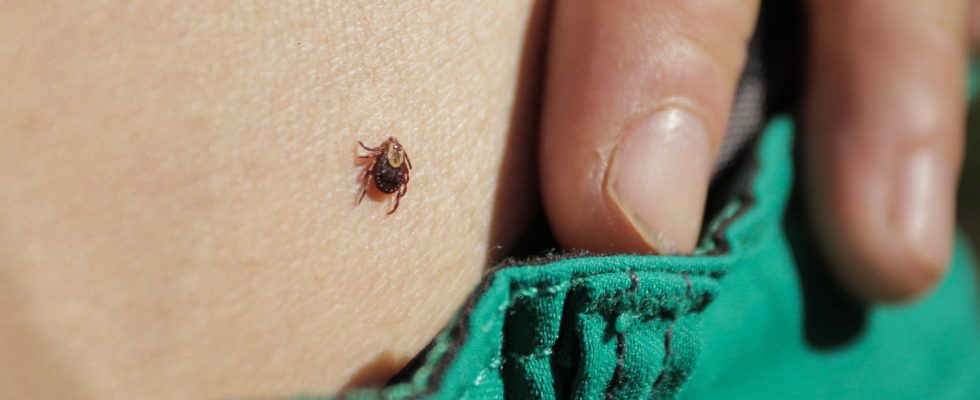Lyme disease appears after the bite of a tick carrying Borrelia bacteria. The first symptom is cutaneous, but other later symptoms may appear.
“When you get bitten by a tick, there is more than 95% chance of having no disease“, reassures Dr. Alice Raffetin, coordinator of the Reference Center for Vector-borne Tick Diseases, Paris and northern region. Indeed, to be affected by Lyme disease, you must be bitten by a tick. carrier of Borrelia bacteria. Gold, “when walking in a wet area where ticks are found, only 15% of ticks are infected.”
1. A red spot around the bite, the first warning sign
Erythema migrans is the first visible sign after a tick bite. This is a skin lesion that appears on the body at the bite. This takes the form ofan oval or round spot which can expand centrifugally to reach up to 30 cm in diameter. “This lesion does not hurt, is not hot and does not scratch so it can easily go unnoticed depending on its location. This phase usually occurs one week after the bite And can occur up to three months after“, explains Dr. Alice Raffetin. There is no sequelae after an erythema migrans. On the other hand, in certain cases, “the erythema migrans can become multiple. Spots then appear in several places on the body“, she continues. When the erythema is not treated initially, the bacteria can migrate away from the bite: we speak of disseminated forms.
2. A small lump on the earlobe
A lymphocytoma is a small red to purplish lump (nodule) of 1 to 3 cm in diametersometimes painful, can develop mainly at the level earlobe, nipple or testicles.
3. Red lesions on fingers or toes
Rare and late cutaneous form of Lyme disease, chronic atrophic acrodermatitis corresponds to a skin lesion of the end of a limb (hand or foot) most often, red to purplish, flat, complicated by edema at the beginning, followed by atrophy of the skin in the very late phases.
4. Arthritis in the joints
“When the bacterium is in the blood, it can lodge in several compartments of the body, in particular the joints. Lyme disease mainly affects large joints such as the knee. In the majority of cases, it swells enormously but is not necessarily painful: it is typical of Lyme arthritis“, continues our interlocutor.
5. Facial paralysis
Lyme disease can also present with neurological system symptoms For example, “radiculitis which occurs when the bacteria gets in the way of a nerve. This causes pain resembling sciatica, for example, occurring mainly at night and not responding to the usual treatment for sciatica. This should suggest neuroborreliosis., says Dr. Alice Raffetin. Another characteristic sign: facial paralysis which is sometimes accompanied by severe pain in the facial nerve. This is reversible with treatment and usually leaves no sequelae.
6. A moderate fever
Some symptoms may be accompanied by fever but this is often not very high. Headaches may also occur from the onset of the first symptoms but are often related to fatigue or when a neurological impairment exists.
All symptoms of Lyme disease are treated by antibiotics. Only the duration of taking the treatment varies according to the symptom:
- Erythema migrans: 10 to 14 days of antibiotics
- Lymphocytoma: 21 days of antibiotics
- Chronic atrophic acrodermatitis: 28 days of antibiotics
- Joint damage: 28 days of antibiotics
- Neurological damage: 14 to 21 days of antibiotics.
Despite antibiotics, some patients may experience post-infectious symptoms as may be the case after a Covid or Chikungunia infection. “Some patients present immune cascades that lead to chronic joint pain, fatigue, tingling and yet all examinations are normal. These symptoms eventually disappear and 99% of patients recover despite the post-infectious syndrome. We sometimes hear that the bacterium becomes chronic, but this has never been demonstrated by science. The whole challenge of research is to better identify the mechanisms of these deregulations in order to treat the patient as early as possible from these post-infectious symptoms.“.
Thanks to Dr Alice Raffetin, coordinator of the Reference Center for Tick Vector Diseases, Paris and Northern region.
